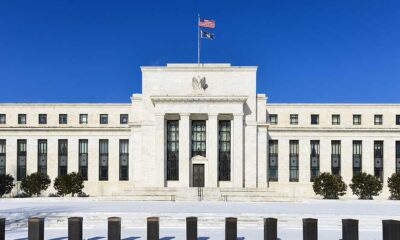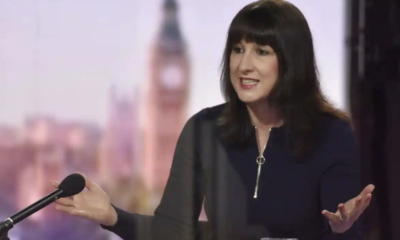Finance
Investors expect the Fed to scale back its rate cut forecasts for 2024
Investors are on edge this week as Federal Reserve officials prepare to signal how many more rate cuts are likely in 2024.
Most market watchers believe policymakers will adjust their expectations. The question is how many.
Wednesday’s new projection will take the form of a so-called “dot plot,” a graph updated quarterly that shows each Fed official’s forecast for the direction of the federal funds rate.
In March, the dot plot revealed a consensus among Fed officials on three cuts. Now that projection has been called into question after a series of persistent inflation data, cautious commentary from Fed officials and a U.S. labor market that created more jobs than expected in May.
Most investors now expect little more than just one cut before 2024.
“I think the policy path will change a little bit,” said Esther George, former chair of the Kansas City Fed, who predicts the median among 19 policymakers could fall to one cut, even as a healthy number of officials still advocate two.
“My expectation is that the dots will show and confirm what I think the market has picked up, and that means fewer rate cuts if inflation forecasts hold.”
Fed Chairman Jay Powell and his colleagues on the Federal Open Market Committee have emphasized that they want to make sure inflation moves toward the 2% target “sustainably” before they begin cuts, and that in the meantime they expect keep interest rates high for longer. .
This attitude is not expected to change this week. Officials are widely expected to hold Fed rates steady on Wednesday, keeping them at a 23-year high.
A mixed picture
Policymakers are expected to remain cautious as the latest inflation and economic data provide a mixed picture.
The labor market added 272,000 nonfarm payroll jobs in May, significantly more than the 180,000 economists expected, but the unemployment rate rose from 3.9% to 4%.
Prices aren’t accelerating as much as they were in the first quarter, but recent readings also don’t show enough progress for the Fed to start cutting spending.
The year-on-year increase in the Fed’s preferred inflation measure – the “core” personal consumption expenditure index – was 2.8% in April, unchanged from March.
Another complication is that wages are also showing resilience. Wage growth was stronger than expected in May at 4.1%.
Fed officials will get a new reading from another inflation gauge, the Consumer Price Index (CPI), just hours before they conclude their policy meeting next Wednesday. The economy is expected to show continued moderation in May, after an encouraging April.
The year-over-year change in the so-called “core” CPI — which excludes volatile food and energy prices over which the Fed has no control — is expected to fall by a tenth of a percent to 3.5%, down from 3.6 % in April and 3.8% in March.
According to George, a 3.5% push on the CPI may not be enough to inspire confidence in the Fed.
“I think it’s going to take a little longer for them to figure out what the trend is,” George said.
Bet on September
Powell has made clear that he thinks the Fed will need more than a quarter of data to assess whether inflation is steadily falling toward the central bank’s 2% target.
The September meeting is seen by many as an optimistic case for a rate cut, as the three inflation reports due between now and then should all show improvement before the central bank pulls the trigger.
Meanwhile, investor expectations about the number of interest rate cuts this year have changed dramatically.
Odds on a first rate cut in September fell to around 52% after Friday’s better-than-expected jobs report, and bets on a second rate cut fell to just over 38% in December.
Luke Tilley, chief economist at Wilmington Trust, is more optimistic. He expects the central bank will have sufficient data to change its course at its policy meeting on July 31.
Inflation data in the first month of the second quarter helped allay fears of warmer data in the first quarter, he said, and Wednesday’s CPI data will provide further reassurance.
“By the time July 31st rolls around, they will still have three months of inflation data,” Tilley said. “I think they’re back on their feet and ready to cut. But it really comes down to how that data comes out.”
On Wednesday, investors will also be able to digest other new projections from the Fed this week, as policymakers will also make new forecasts on inflation, the economy and unemployment.
And what Powell has to say at his regular post-meeting press conference will be given the usual high degree of attention.
Wilmer Stith, bond portfolio manager at Wilmington Trust, wonders whether Powell is taking a more aggressive tone.
“Will he be like one [Minneapolis Fed President Neel] Kashkari and other members who say we should be higher for longer?” says Stith.
“It’s hard to say because if we continue to have the economic growth and the strength of the labor market that we’ve seen, I don’t even know why they would want to make one cut.”
Stith said he thinks officials will make two rate cuts. If the Fed downgrades just one, it could cause some volatility in the markets, he added, even though that’s currently what investors expect.
There is a risk that the Fed becomes too patient in its quest to ensure inflation falls, George said. If interest rates are kept high for too long, it could also sow the seeds of a recession.
“That’s the risk they run here, is to say time is on our side,” she said.
Click here for an in-depth analysis of the latest stock market news and events affecting stock prices.
Read the latest financial and business news from Yahoo Finance









